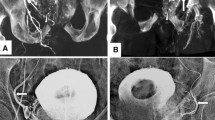Abstract
Objective
To evaluate the efficacy and safety of transurethral ethanol ablation of the prostate (TEAP) for patients with symptomatic benign prostatic hyperplasia (BPH) and high-risk comorbidities.
Materials and methods
Thirty-six patients (mean age 77.3 years) with symptomatic BPH or persistent urinary retention were assessed at baseline and at 3, 6, and 12 months after treatment. All patients were affected by comorbidities (cardiovascular, respiratory, hematologic, neoplastic, dysmetabolic diseases, or coagulation disorders). Baseline evaluation was achieved by the International Prostate Symptom Score (IPSS) and quality of life (QoL) score, prostate-specific antigen (PSA), prostate transrectal ultrasound (TRUS), and the maximum peak flow rate with evaluation of post-voiding residual urine volume (PVR). Treatment was performed by injecting dehydrated ethanol at a rate correlated to prostate volume into the prostate. The primary end-point for response was ≥80% improvement of the maximum peak flow rate and significant reduction of the PVR; secondary end-points included symptom improvement (≥40% reduction in IPSS and QoL scores). Statistical analysis was carried out with Pearson’s Chi-square test and the non-parametric Wilcoxon test with an assigned statistical significance at P < 0.05.
Results
During the active follow-up period, we observed a statistically significant decrease of the baseline at the end of the study in the total IPSS score and in the QoL score. The mean peak flow rate improved from 6.0 ± 2.40 ml/min to 15.2 ± 0.14 ml/min (P < 0.001), while the PVR decreased from a baseline value of 290.6 ± 14.14 ml to 4.2 ± 14.10 ml (P < 0.001).
Conclusion
We found that TEAP is a safe minimally invasive treatment, which significantly improves voiding dysfunctions in patients with symptomatic BPH.

Similar content being viewed by others
References
Cabelin MA, Te AE, Kaplan SA (2000) Benign prostatic hyperplasia: challenges for the new millennium. Curr Opin Urol 10:301–306
Schumm-Draeger PM (1998) Ultrasound-guided percutaneous ethanol injection in the treatment of autonomous thyroid nodules—a review. Exp Clin Endocrinol Diabetes 106(4):S59–S62
Livraghi T, Festi D, Monti F et al (1986) US-guided percutaneous alcohol injection of small hepatic and abdominal tumors. Radiology 161:309–312
Banner M (1998) Percutaneous renal cyst ablation. In: Banner M (ed) Radiologic interventions uroradiology. Williams & Wilkins, Baltimore, pp 73–77
Gelezer RK, Charbonneau JW, Hussain S et al (1999) Ethanol injection therapy of the prostate for benign prostatic hyperplasia: preliminary report on application of a new technique. J Urol 162:383–386
Harkaway RC, Issa MM (2006) Medical and minimally invasive therapies for the treatment of benign prostatic hyperplasia. Prostate Cancer Prostatic Dis 9(3):204–214
Stovsky MD, Griffiths RI, Duff SB (2006) A clinical outcomes and cost analysis comparing photoselective vaporization of the prostate to alternative minimally invasive therapies and transurethral prostate resection for the treatment of benign prostatic hyperplasia. J Urol 176:1500–1506
Mebust WK, Holtgrewe HL, Cockett AT et al (2002) Transurethral prostatectomy: immediate and postoperative complications. A cooperative study of 13 participating institutions evaluating 3,885 patients. 1989. J Urol 167(2 Pt 2):999–1003
Larson TR (2002) Rationale and assessment of minimally invasive approaches to benign prostatic hyperplasia therapy. Urology 59(2 Suppl 1):12–16
AUA Practice Guidelines Committee (2003) AUA guideline on management of benign prostatic hyperplasia (2003). Chapter 1: diagnosis and treatment recommendations. J Urol 170:530–547
de la Rosette J, Alivizatos G, Madersbacher S et al, European Association of Urology (2001) EAU guidelines on benign prostatic hyperplasia (BPH). Eur Urol 40:256–264
Zvara P, Karpaman E, Stoppacher R et al (1999) Ablation of canine prostate using transurethral intraprostatic absolute ethanol injection. Urology 54:411–415
Plante MK, Bunnell ML, Trotter SJ et al (2002) Transurethral prostatic tissue ablation via a single needle delivery system: initial experience with radio-frequency energy and ethanol. Prostate Cancer Prostatic Dis 5:183–188
Ditrolio J, Patel R, Watson RA et al (2002) Chemo-ablation of the prostate with dehydrated alcohol for the treatment of prostatic obstruction. J Urol 167:2100–2104
Plante M, Anderson R, Badlani G et al (2003) Transurethral ethanol ablation of the prostate using local anesthesia. J Endourol 17(Suppl 1):A158
Gutierrez J, Di Grazia R, Favela R et al (2003) Transurethral ethanol ablation of the prostate, can it be performed under local anesthesia? J Endourol 17(Suppl 1):A159
Grise P, Plante M, Palmer J et al (2004) Evaluation of the transurethral ethanol ablation of the prostate (TEAP) for symptomatic benign prostatic hyperplasia (BPH): a European multi-center evaluation. Eur Urol 46:496–502
Plante MK, Marks LS, Anderson R et al (2007) Phase I/II examination of transurethral ethanol ablation of the prostate for the treatment of symptomatic benign prostatic hyperplasia. J Urol 177:1030–1035
Author information
Authors and Affiliations
Corresponding author
Rights and permissions
About this article
Cite this article
Magno, C., Mucciardi, G., Galì, A. et al. Transurethral ethanol ablation of the prostate (TEAP): an effective minimally invasive treatment alternative to traditional surgery for symptomatic benign prostatic hyperplasia (BPH) in high-risk comorbidity patients. Int Urol Nephrol 40, 941–946 (2008). https://doi.org/10.1007/s11255-008-9394-z
Received:
Accepted:
Published:
Issue Date:
DOI: https://doi.org/10.1007/s11255-008-9394-z




